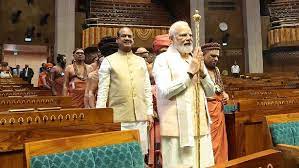NEW DELHI: Prime Minister Narendra Modi on Sunday morning officially opened India’s new Parliament House complex with the installation of the historic Sengol that has marked the transfer of power from the British to Indians in 1947.
At that time India’s first prime minister Jawaharlal Nehru had received the Sengol from Tamil Nadu’s high priests who had earlier received it from the last Governor General Lord Mountbatten.
As in 1947, the receipt of the Sengol by the head of government (PM) was also preceded by chanting of hymns and elaborates rituals by Tamil Nadu’s high priests who are guests at the inauguration.
The PM received the scepter that was given to the ruler under Chola traditions and installed it near the chair of Lok Sabha speaker, Om Birla who was accompanying the PM at the time of the installation.
Later, the PM lit the traditional lamp to inaugurate the building and the multi-faith prayers were held.
The PM, earlier, also met workers who built the complex defining a resurgent India and honoured them.
After the prayers, the PM is expected to give his remarks later today.
It is 96 years after the colonial-era-Parliament was inaugurated by then Governor-General Lord Irwin on January 18, 1927, that India today got a new Parliament Complex, which has been inaugurated on the 140th anniversary of Hindutva icon Vinayak Damodar Savarkar.
Twenty one Opposition parties skipped the event protesting the inauguration by the PM while they had insisted on President Dropuadi Murmu.
Twenty five parties, including 18 ruling NDA constituents are attending.
Unlike the current building, which was designed by English architects Herbert Baker and Edwin Lutyens, the new one has been conceptualised and created by Indian architect Bimal Patel, and will have the capacity to seat 888 members in the Lok Sabha and 300 in Rajya Sabha.
The present building can accommodate only 543 Members in the Lok Sabha and 250 in the Rajya Sabha.
“The present building was never designed to accommodate a bicameral legislature for a full-fledged democracy. The number of Lok Sabha seats has remained unaltered at 545 based on the delimitation carried out on the basis of 1971 Census. It is likely to increase substantially after 2026 as the freeze on total number of seats is only till 2026. The seating arrangements are cramped and cumbersome, with no desks beyond the second row. The Central Hall has seating capacity only for 440 persons. When the Joint Sessions are held, the problem of limited seats amplifies. Due to limited space for movement, it is also a huge security risk,” says the government, in justification of the new structure, which Union Home Minister Amit Shah today hailed saying, “The new Parliament building is an architectural marvel that represents the resolve of 1.4 billion Indians to build a new nation under PM Modi.”
Union urban affairs minister Hardeep Puri said: “India’s magnificent new Parliament stands as tall as India’s resolve to go all guns blazing into a glorious future.”
While the prayers were on senior Congress leader Jairam Ramesh tweeted: “On this day, May 28th: Nehru, the person who did the most to nurture Parliamentary democracy in India, was cremated in 1964, Savarkar, the person whose ideological ecosystem led to the killing of Mahatma Gandhi, was born in 1883, The President the first Adivasi to become President is not allowed to fulfil her Constitutional duties and inaugurate the New Parliament building in 2023, a self-glorifying authoritarian Prime Minister with utter disdain for Parliamentary procedures, who rarely attends Parliament or engages in it, inaugurates the New Parliament building in 2023, and Fabrication of facts by Distorians hits new lows in 2023.”


